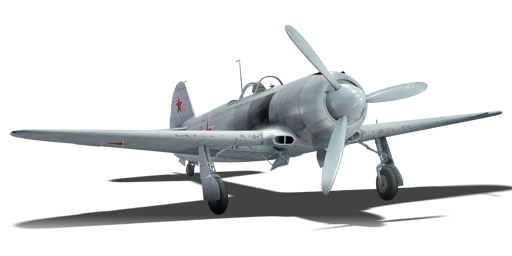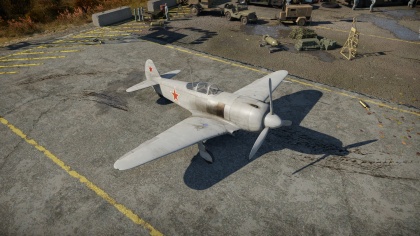Yak-3U
Contents
| This page is about the Russian fighter Yak-3U. For other versions, see Yak-3 (Family). |
Description
The Yak-3U is a rank IV Russian fighter
with a battle rating of 5.7 (AB/RB) and 6.0 (SB). It was introduced in Update 1.89 "Imperial Navy".
General info
Flight performance
The Yak-3U is the pinnacle of the Yakovlev piston engine fighter design, combining the amazing agility of the Yak-3 airframe with the excellent Shvetsov M-82FN engine acquired from the Lavochkin line, increasing its top speed tremendously. One can expect a similar playstyle to the feared Yak-3P but turned up a few notches due to the improvement in speed. However, the big elephant in the room is the woefully inadequate armament for the tier; two B-20S 20 mm cannons mounted in the nose are unable to compete with other aircraft in the BR 6.3 range, or even other Soviet aircraft at the same tier such as the I-225. Thus, the pilot should aim for critical components (engines, wings or pilot) in order to secure a kill.
| Characteristics | |||||||
|---|---|---|---|---|---|---|---|
| Stock | |||||||
| Max Speed (km/h at 6,000 m) |
Max altitude (meters) |
Turn time (seconds) |
Rate of climb (meters/second) |
Take-off run (meters) | |||
| AB | RB | AB | RB | AB | RB | ||
| 668 | 649 | 10500 | 18.2 | 19.4 | 21.6 | 21.6 | 360 |
| Upgraded | |||||||
| Max Speed (km/h at 6,000 m) |
Max altitude (meters) |
Turn time (seconds) |
Rate of climb (meters/second) |
Take-off run (meters) | |||
| AB | RB | AB | RB | AB | RB | ||
| 729 | 695 | 10500 | 17.2 | 18.0 | 32 | 26.5 | 360 |
Details
| Features | ||||
|---|---|---|---|---|
| Combat flaps | Take-off flaps | Landing flaps | Air brakes | Arrestor gear |
| X | X | ✓ | X | X |
| Limits | ||||
|---|---|---|---|---|
| Wing-break speed (km/h) |
Gear limit (km/h) |
Combat flaps (km/h) |
Max Static G | |
| + | - | |||
| 0 | 320 | 410 | ~11 | ~8 |
| Optimal velocities | |||
|---|---|---|---|
| Ailerons (km/h) |
Rudder (km/h) |
Elevators (km/h) |
Radiator (km/h) |
| < 380 | < 420 | < 490 | > 341 |
| Compressor (RB/SB) | ||
|---|---|---|
| Setting 1 | ||
| Optimal altitude | 100% Engine power | WEP Engine power |
| 1,550 m | 1,630 hp | 1,920 hp |
| Setting 2 | ||
| Optimal altitude | 100% Engine power | WEP Engine power |
| 4,550 m | 1,430 hp | N/A |
Survivability and armour
- 64 mm sloped bulletproof glass behind the pilot
- 8.5 mm steel plate behind the pilot seat
Armaments
Offensive armament
The Yak-3U is armed with:
- 2 x 20 mm B-20S cannons, nose-mounted (120 rpg = 240 total)
Usage in battles
Being an improvement on the Yak-3P, one can expect a similar playstyle to the feared Red Russian Menace, but with more versatility thanks to the improved engine providing a large increase in speed. The -3U provides quite a unique experience, as it can out-turn the enemies it can't out-run, and it can outrun the enemies it can't out-turn, so a smart pilot will use this versatility to their advantage. One should stick with energy fighting for the most part, but can certainly turn-fight with less manoeuvrable opponents, which include the P51 line.
The main drawbacks of the 3U are its poor armament and poor performance above 2,000 m. The two B-20S cannons provide lacklustre stopping power at this tier and have a nasty habit of sparking, and to top it off, they have a low ammunition count of 120 rounds per gun. Due to the lack of a supercharger, the engine's output greatly decreases above 2,000 m; it is recommended to entice opponents (mainly Germans & Americans) down to altitude in order to engage them. The solid performance combined with the weak armament makes the -3U a very volatile plane. A newer or inexperienced player may find the performance enticing, but will struggle to do well if they're too trigger happy and have not used to the Russian 20 mm's very much. However, a good pilot will be able to use the upsides to these cannons (accuracy, high rate of fire and ability to start fires) to their advantage. Also worth noting is that Armored-Target belts from these cannon tend to set fuel tanks on fire quite easily, so aiming at them and at the engines of enemy aircraft will likely yield bright, warm results. The Tracers belt is also a noteworthy option, as it is only IAI ammunition, and will easily take off control surfaces with one hit, as well as help someone who is not so confident with the ballistics of the cannons aim.
Manual Engine Control
| MEC elements | ||||||
|---|---|---|---|---|---|---|
| Mixer | Pitch | Radiator | Supercharger | Turbocharger | ||
| Oil | Water | Type | ||||
| Not controllable | Controllable Not auto controlled |
Controllable Auto control available |
Controllable Auto control available |
Separate | Controllable 2 gears |
Not controllable |
Modules
| Tier | Flight performance | Survivability | Weaponry | |
|---|---|---|---|---|
| I | Fuselage repair | Radiator | Offensive 20 mm | |
| II | Compressor | Airframe | ||
| III | Wings repair | Engine | New 20 mm cannons | |
| IV | Engine injection | Cover | ||
Pros and cons
Pros:
- Very fast for a propeller-driven aircraft, able to out-run the P51 D-5 at low altitude
- Amazing maneuverability that can compete with almost every aircraft at the rank
- Solid climb rate
- Immense energy retention
- Fast firing and accurate cannons concentrated in the nose that are devastating in short, well-placed bursts at close range
- Bulletproof glass in the rear of the cockpit will prevent pilot snipes if you're being chased
- Outstanding acceleration due of the M-82FN Radial engine
- Not as prone to overheating as other Yaks
- Can reach 6000 m in a frontclimb when spaded and still perform well...
Cons:
- ...But it's a double edged sword since it have the M-82FN engine that suffocates above 3500 m and has no WEP at this altitude
- Airframe is quite weak
- Susceptible to fires
- Twin cannon setup provides poor firepower for its rank
- Despite the high speed for a Russian prop, it's still not enough to keep up with some enemies in a dive, primarily due to wing ripping at lower speeds than those of a diving P51 or Corsair.
- No bulletproof glass in the front of the plane, so hard to use against planes with defensive turrets
- Very limited ammunition load combined with the fast fire rate makes a trigger happy player run out of ammo very quickly
- No combat flaps option, just like all Yak propeller fighters
- No bulletproof glass in the front cockpit (avoid bombers & headons)
- Low rip speed for a prop of its rank (around 750 km/h)
History
The Yak-3U is based on the Yak-3 VK-105PF 2 variant, with some major modifications. A Yak-3U is also referred as Yak 3U/Ash-82FN. It was first flown on the 29th of April 1945, it was developed by Yakovlev design bureau and powered by the almighty Ash-82FN engine. It was one of the best power plants in the world at that time. Created by Design Bureau No. 19 and manufactured by Factory No. 478, it provided 1,850 BHP. This is the same engine as used on other legendary & iconic Russian fighter and attacker aircraft, such as the Tu-2's, La-5's & La-7's.
The engine was designed in the Soviet Union (Russia) by Design Bureau No. 19 it was a technological innovation based on it's licensed built version Wright R-1820 cyclon power plant. The Ash-82FN featured direct fuel and afterburner injection systems to give it an additional output of 250 BHP, bringing it up-to 1850 BHP! Giving it a top speed of 705 KPH (438 MPH) over it's western counterpart Wright R-1820 which only provided 1,600 BHP. The Ash-82FN allowed the Yak-3U, to hit 5 KM in 3 minutes.
This plane would not enter mass production as the war was nearing the end and jet technology would become the priority for Union of Soviet Socialist Republics, U.S.S.R. This plane would become the foundation, for the legendary Yak U trainer aircraft, later to become the Yak 11.
The main differences of this modification are major modifications of the air frame over the Yak-3 VK-105PF 2 variant with:
- Installation of the Ash-82FN engine, Design Bureau No. 19 with up-to 1,850 BHP, direct fuel and afterburner injection systems gave it a top speed of 705 KPH (438 MPH).
- Twin B-20S cannons, with 120 rounds per gun, total of 240 rounds with burst of 2.40 kg per second!
- Larger wing span, 9.4 meters, it was additionally moved forward by 219 mm.
- Cockpit placed 84 mm higher.
- Plywood fuselage skin.
- Metal tail and metal ailerons.
- Weight and drag reduction.
- All metal wing upgrade.
- Longer landing legs increased by 80 mm, allowed for better control.
Media
See also
External links
| A.S. Yakovlev Design Bureau (Яковлев Опытное конструкторское бюро) | |
|---|---|
| Fighters | |
| Yak-1 | Yak-1 · Yak-1B |
| Yak-3 | Yak-3 · Eremin's Yak-3(e) · Yak-3 (VK-107) · Yak-3P · Yak-3T · Yak-3U |
| Yak-7 | Yak-7B |
| Yak-9 | Yak-9 · Yak-9B · Yak-9K · Golovachev's Yak-9M · Yak-9P · Yak-9T · Yak-9U · Yak-9UT |
| Twin-engine fighters | I-29 |
| Jet fighters | |
| Yak-15 | Yak-15P · Yak-15 |
| Yak-17 | Yak-17 |
| Yak-23 | Yak-23 |
| Yak-30 | Yak-30D |
| Yak-141 | Yak-141 |
| Strike aircraft | |
| Yak-2 | Yak-2 KABB |
| Yak-38 | Yak-38 · Yak-38M |
| Bombers | Yak-4 |
| Jet bombers | Yak-28B |
| Foreign use | ▄Yak-3 · Challe's ▄Yak-9T · ◔Yak-9P |
| Captured | ▀Yak-1B |
| USSR fighters | |
|---|---|
| I-15 | I-15 WR · I-15 M-22 · I-15 M-25 · I-15bis · Krasnolutsky's I-15bis |
| I-153 M-62 · Zhukovsky's I-153-M62 · I-153P | |
| I-16 | I-16 type 5 · I-16 type 10 · I-16 type 18 · I-16 type 24 · I-16 type 27 · I-16 type 28 · I-180S |
| I-29 | I-29 |
| I-185 | I-185 (M-71) · I-185 (M-82) |
| I-225 | I-225 |
| ITP | ITP (M-1) |
| MiG-3 | MiG-3-15 · MiG-3-15 (BK) · MiG-3-34 |
| LaGG | I-301 · LaGG-3-4 · LaGG-3-8 · LaGG-3-11 · LaGG-3-23 · LaGG-3-34 · LaGG-3-35 · LaGG-3-66 |
| La | La-5 · La-5F · La-5FN · La-7 · Dolgushin's La-7 · La-7B-20 · La-9 · La-11 |
| Yak-1/7 | Yak-1 · Yak-1B · Yak-7B |
| Yak-3 | Yak-3 · Eremin's Yak-3(e) · Yak-3P · Yak-3T · Yak-3U · Yak-3 (VK-107) |
| Yak-9 | Yak-9 · Yak-9B · Golovachev's Yak-9M · Yak-9T · Yak-9K · Yak-9U · Yak-9UT · Yak-9P |
| Other countries | ▂P-40E-1 · ▂P-47D-27 · ▂Hurricane Mk IIB · ▂Fw 190 D-9 · ▂Spitfire Mk IXc |
| P-39 | ▂P-39K-1 · ▂Pokryshkin's P-39N-0 · ▂P-39Q-15 |
| P-63 | ▂P-63A-5 · ▂P-63A-10 · ▂P-63C-5 |





